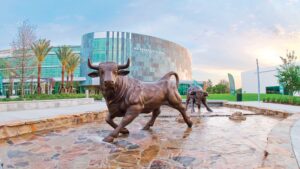The impact of USF’s largest freshman class

The university welcomed its largest freshman class this year, making a total attendance of 51,060 students at USF. There are 5,703 freshmen, including First Time in College (FTIC) and “other freshmen,” according to the USF InfoCenter, the university’s online database for student admissions.
The increase in USF’s FTIC population — 481 more students in fall 2019 than in fall 2018, according to InfoCenter — has impacted many departments such as USF Dining Services and the Counseling Center. Ultimately, the growth has contributed to longer wait times around campus.
Over 19,000 FTIC students for the entire campus population were accounted for this fall versus the 18,000 FTIC students that were for the prior year. This impacted the Tampa campus the most with 17,264 FTIC students this year compared to 16,386 in 2018.
As well as the largest freshman class, USF has also welcomed its most diverse class.
For FTIC students, “black student enrollment has increased by 33 percent from last year, Asian student enrollment has grown by nearly 23 percent and Hispanic student enrollment is up more than 14 percent,” according to the USF website.
Admissions
A key factor in the jump in FTIC students is USF’s decision to join the “Coalition for College,” an invite-only college group that allows students to apply to over 140 colleges across the country. USF joined two years ago and is now seeing a much larger application pool as a result, according to Glen Besterfield, dean of admissions.
Consolidation has also played a part in the long wait times.
“USF St. Pete and USF Sarasota-Manatee’s acceptance criteria were changed to that of USF Tampa’s,” said Besterfield.
Because of the change, St. Pete’s incoming class size decreased by 7.4 percent due to the higher admission criteria.
To keep class size steadily increasing for USF overall, Tampa’s FTIC admissions were higher, with a 26.4 percent increase of FTIC students versus last year’s 9.7 percent increase, resulting in the admission of 731 more people than last year on the Tampa campus.
Dining Services
Jessica Cicalese, the marketing director of USF Dining Services, said the addition of 813 Eats in the Marshall Student Center (MSC) food court and the renovation of the Bullpen to include Chick-fil-A and Bento Sushi came at just the right time.
“[The renovations were] good planning and good timing,” said Cicalese. “This year in particular, this fall, we have seen a lot more students than normal.”
During orientation, Dining Services tracks students’ interest in using dining opinions around campus in order to figure out how many students will use the operations, according to Cicalese.
She said the shift to the food delivery application, Grubhub, for mobile ordering was aimed at cutting the long wait times in response to the larger expected class size.
Counseling Services
Unfortunately, cutting the wait times at the Counseling Center has not been made possible thus far.
“Wait times for [counseling] are upwards of two and a half to three weeks, which is unusual at this point in the year,” said Tom Miller, director of Health and Wellness. “Same thing with the psychiatrists, a delay of two to three weeks.”
To address this situation, Miller said two more counselors are currently being added to the staff roster and temporary employees have been brought in to keep up with the high demand.
Residential Housing
The growth of on-campus housing in the past few years is a response to the growing class size. About 6,600 beds have been filled this year, according to Besterfield.
“In January, when we have another 400, 500 students admitted, I don’t know how we’re going to handle the residential circumstances to that because we’re full,” Miller said. “So, it’s a little disquieting that we might have a whole bunch of students coming down here and they have to live off-campus.”
Looking forward, Besterfield said USF is cutting its FTIC admissions pool and are in favor of accepting more transfers next year.








